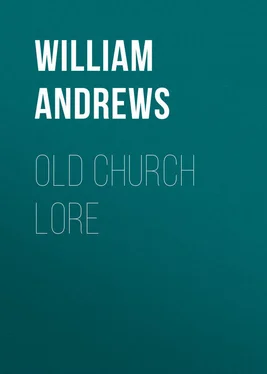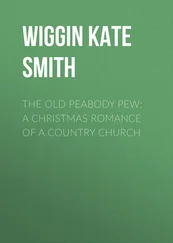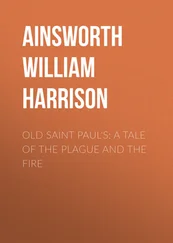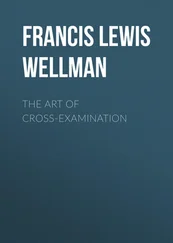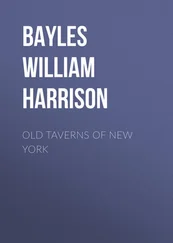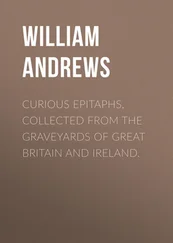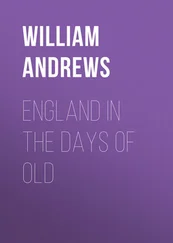William Andrews - Old Church Lore
Здесь есть возможность читать онлайн «William Andrews - Old Church Lore» — ознакомительный отрывок электронной книги совершенно бесплатно, а после прочтения отрывка купить полную версию. В некоторых случаях можно слушать аудио, скачать через торрент в формате fb2 и присутствует краткое содержание. Жанр: foreign_antique, foreign_prose, на английском языке. Описание произведения, (предисловие) а так же отзывы посетителей доступны на портале библиотеки ЛибКат.
- Название:Old Church Lore
- Автор:
- Жанр:
- Год:неизвестен
- ISBN:нет данных
- Рейтинг книги:3 / 5. Голосов: 1
-
Избранное:Добавить в избранное
- Отзывы:
-
Ваша оценка:
- 60
- 1
- 2
- 3
- 4
- 5
Old Church Lore: краткое содержание, описание и аннотация
Предлагаем к чтению аннотацию, описание, краткое содержание или предисловие (зависит от того, что написал сам автор книги «Old Church Lore»). Если вы не нашли необходимую информацию о книге — напишите в комментариях, мы постараемся отыскать её.
Old Church Lore — читать онлайн ознакомительный отрывок
Ниже представлен текст книги, разбитый по страницам. Система сохранения места последней прочитанной страницы, позволяет с удобством читать онлайн бесплатно книгу «Old Church Lore», без необходимости каждый раз заново искать на чём Вы остановились. Поставьте закладку, и сможете в любой момент перейти на страницу, на которой закончили чтение.
Интервал:
Закладка:
Prior to the Reformation, the Chamberlains of Derby rendered annually to the monks of the Priory of St. James two pounds of wax, for the privilege of passing over St. James’ Bridge.
On the old bridge at Rotherham, which spans the river Don, is still standing the chapel of “Our Lady.”
“The sacred taper’s light is gone.”
It is an interesting monument of bygone times, but it is no longer used as a house of prayer. Where once the mass was celebrated by devout priests, a trader keeps a small shop. The earliest mention of this chapel which is known, occurs in the will of John Bokying, master of the Grammar School at Rotherham, and is dated August 24th, 1483. He leaves “To the fabric of the chapel to be built on Rotherham bridge, 3s. 4d.” The design of the building was plain, but, on the whole, its effect must be pronounced pleasing. The dimensions of the building in the interior are thirty-two feet nine inches in length, by fifteen feet five inches in width. Leland, the antiquary, visited the town in the middle of the sixteenth century, and says, “I enterid into Rotheram by a fair stone bridge of iiij arches, and on hit is a chapel of stone, wel wrought.” In old records relating to Rotherham, reproduced by John Guest, F.S.A., in his “Historic Notices of Rotherham,” may be read many items of local interest on this chapel. We find statements respecting the bridge and chapel occupying the attention of the Justices of Peace at Pontefract Sessions and Doncaster Sessions, towards the close of the seventeenth century. The Feoffees of Rotherham successfully maintained that the bridge and chapel belonged to them, but that they had to be kept in repair at the expense of the West Riding. It, at this period, was used as an almshouse for poor people. In the Feoffees records it is stated as follows:
“1778. June 6th. Ordered that the greaves do employ a proper person to examine ye state of ye almshouse, and to report what expence will be necessary to make the same into a dwelling-house for ye deputy-constable, and secure gaols for the receiption of prisoners.”
“1779. February 5th. That the greaves do immediately agree with Mr. Platts for altering the almshouse to a prison, and, according to a plan now in their hands, so that the expense of the alterations do not exceed thirty-six pounds.”
“1779. June 16th. Ordered that John Watson be permitted to inhabit that part of the almshouse designed for the deputy-constable. That the rent of the same shall be five pounds. Only to use the two first rooms and the pantry on the ground floor, and the two chambers over the same. The other parts of the house being designed for other purposes. And that he shall not take out a license to sell ale or spirituous liquors.”
In 1825-6, a new court house was built, and then the bridge-chapel was no longer required as a prison. As we have previously stated, the ancient building is now devoted to business purposes. Let us hope the day is not far distant when it may once more be used as a house of prayer.
Perhaps the most interesting of chapels on bridges, is the one at Wakefield, dedicated to St. Mary. Its history has been carefully compiled by Norrisson Scatcherd, in 1843, by John W. Walker, F.S.A., in 1890, and it has received the consideration of other antiquaries. It has long been a popular, but mistaken belief, that the chapel was built by Edward IV. that masses might be said for those slain in the battle of Wakefield, in 1460, and in which his father, the Duke of York, and his brother, the Duke of Rutland were slain. It will be remembered, that in this engagement, the Lancastrians defeated the Yorkists. It is clear, from Mr. Walkers work, that the beautiful chapel was built by the townsmen of Wakefield, and there is not any trace of the King adding anything to the revenues of the chapel. When the first bridge was built over the Calder, is not known, but, in 1342, King Edward III. granted to the bailiffs of the town the right of tollage for three years, on all goods for sale and cattle passing over the bridge, “as a help towards repairing and improving the bridge,” which is stated to be “rent and broken.” In the documents, there is not any mention of a chapel, a bridge only is referred to. Mr. Walker is of opinion that about this time the suggestion was first made for the erection of a chapel in honour of the Blessed Virgin Mary, and that it was soon carried into effect. Three townsmen and two priests obtained the first license, in 1356-7. In a decree, bearing date of November 20th, 1444, it says the chapel is “Wholly built of costly stonework by the inhabitants and community of Wakefield.” It has been suggested that, for a time, the black death, which caused such terrible desolation in the country, in 1349-50, may, for a period, have stopped the building of the chapel. It was a noble structure when completed, the carving being especially fine. On the west front, were carvings representing the five glorious mysteries of the Rosary. We give a picture of the central figures, illustrating the Resurrection. It will be seen that Christ is rising from the tomb, and on either side of him are two angels engaged in prayer. In front of the tomb are three soldiers, placed there as guards, and they are clad in complete armour of the time of Edward III. An important feature of the Wakefield bridge-chapel is the crypt. “This,” says Scatcherd, “has undoubtedly been the dwelling of the priests – where they might have lodged strangers, or administered relief.” There was a high turret, reached by a little spiral staircase. On this elevated part of the building was kindled the cresset-light, which would guide the wayfarer, and possibly assist the navigator on the river Calder, when day had given way to night.
Конец ознакомительного фрагмента.
Текст предоставлен ООО «ЛитРес».
Прочитайте эту книгу целиком, купив полную легальную версию на ЛитРес.
Безопасно оплатить книгу можно банковской картой Visa, MasterCard, Maestro, со счета мобильного телефона, с платежного терминала, в салоне МТС или Связной, через PayPal, WebMoney, Яндекс.Деньги, QIWI Кошелек, бонусными картами или другим удобным Вам способом.
Интервал:
Закладка:
Похожие книги на «Old Church Lore»
Представляем Вашему вниманию похожие книги на «Old Church Lore» списком для выбора. Мы отобрали схожую по названию и смыслу литературу в надежде предоставить читателям больше вариантов отыскать новые, интересные, ещё непрочитанные произведения.
Обсуждение, отзывы о книге «Old Church Lore» и просто собственные мнения читателей. Оставьте ваши комментарии, напишите, что Вы думаете о произведении, его смысле или главных героях. Укажите что конкретно понравилось, а что нет, и почему Вы так считаете.
